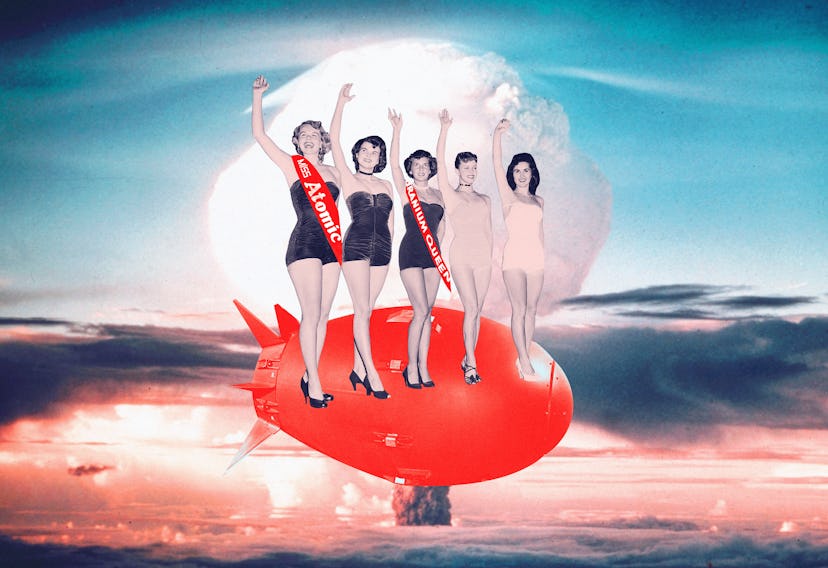Irradiate Me, Baby
It's Not Just Barbenheimer. Women & Nukes Have Always Been Connected.
Long before Barbie met Oppenheimer, the two were linked in the American imagination.

America has made a lot of things, but two of its most enduring will likely be plastic (because of the microplastics) and radiation (because of the half-life). So it’s only fitting that these two 20th-century innovations find themselves competing against one another at the box office this month, as embodied by Greta Gerwig’s Barbie and Christopher Nolan’s Oppenheimer, both of which have July 21 release dates. And since juxtaposition is the internet’s love language — what could be funnier than two things that are different? — it was practically a forgone conclusion that the films would collide and multiply in fans’ imaginations, setting off a fanmade fusion bomb. The phenomenon began online with mashup posters and memes, then grew until the paper of record was reporting on “Barbenheimer” double features.
Thus, the concept of Barbenheimer was born. But here’s the thing: This 2023 phenomenon did not invent the girly nuke. In fact, the mashup posters, with their hot pink explosions and smiling Margots Robbie, are in some ways more accurate to the actual social history of the atomic bomb than the bleak Oppenheimer posters.
The word “bombshell” itself, as used to describe hot women, is a relic of the same wartime era, likely popularized by the 1933 film Bombshell, starring Jean Harlow. In 1941, the first conical bra was introduced, and it was quickly dubbed the “bullet bra” or “torpedo bra.” It was partially tied to wartime propaganda, sure, but like quantum particles, anxieties have a way of entangling, and it appears this is just what happened as men struggled to reconcile their fear of and fixation with women, at the same time that weapons of mass destruction provoked both imperialist verve and unease. Or maybe there was just something in the air. (Radiation. Radiation was in the air.)
If anything, missile design leans phallic, but in the 1940s, nuclear weapons were highly associated with women — specifically white women, because racism. For an idea of how blindingly white the government, corporate class, and general American imagination was at the time, just watch Oppenheimer. (But take care, as much like its subject matter, the film’s cast is liable to cause solar retinopathy.)
In part, this correlation may have grown out of GIs’ well-known love of pinup models, whose portraits they were known to paint on their planes. In 1946, scientists took this idea a step further, placing an image of Rita Hayworth on a test bomb and christening it “Gilda,” after her 1946 film of the same name. The joke must have seemed fitting to the scientists, as Gilda’s trailer did explicitly call the titular character “Beautiful, deadly… using all a woman’s weapons.” (It did not explain what weapons women could wield, exactly, considering at the time they could be legally discriminated against, couldn’t open their own bank accounts, and had little to no say over their reproductive health.) Regardless, it was a neat trick of displacement, to have a pretty girl embody Death, destroyer of worlds, rather than the good old boys pulling the trigger. For her part, Hayworth reportedly “almost went insane, she was so angry” after learning of her namesake nuke, but was dissuaded from speaking out publicly, lest she seem unpatriotic.
Because nukes were patriotic! The shame that suffuses Oppenheimer would take some time to come to the fore. Shortly after the U.S. murdered hundreds of thousands of civilians in Hiroshima and Nagasaki, Gallup polls showed 85% of Americans approved of the decision; even by 1948, a Fortune poll showed 51% believed the Japan bombings represented the use of nuclear force in “just about the right way,” while 15% thought we should’ve used more A-bombs.
Around the same time, a French designer unveiled a boundary-breaking two-piece swimsuit, and named it the bikini after Bikini Atoll, the island where our girl Hayworth was nonconsensually detonated in 1946. The look was designed to debut with a bang, but its name also conveyed a warning: Watch out boy, she’ll blow you up.
Then there were the pageants: festive affairs where aspiring Barbenheimers competed to be named “Miss Atomic” or “Miss Uranium.” The most famous of these beauty queens was Lee Merlin, who was crowned “Miss Atomic Bomb” in a 1957 Las Vegas competition, and was photographed wearing a mushroom cloud affixed to her swimsuit. Two years later, in 1959, Mattel released the first-ever Barbie doll, clad in a strapless one-piece swimsuit — just like Lee’s, but without the cloud.
Today, the specter of these original atomic beauty queens has come back to haunt us at the box office. There’s a whiff of the inevitable about the whole thing, as if Barbie Land had ceased exporting Barbenheimers, but always planned to resume one day. Like the original Barbie doll’s plastics and the first test bomb’s radiation, there are some things America just can’t shake.